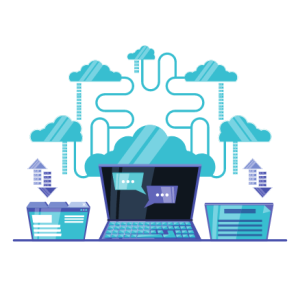Home » A Comprehensive Guide to Cloud Computing: Navigating the Cloud
In today’s digital age, where data is regarded as the new currency, businesses and individuals alike are constantly looking for new ways to store, manage, and use their data more efficiently. Cloud computing has emerged as a transformative technology, providing unprecedented flexibility, scalability, and accessibility. In this comprehensive guide, we’ll look at the intricacies of cloud computing, including its advantages, challenges, and future trends.
Understanding Cloud Computing
Cloud computing is defined as the pay-as-you-go delivery of computing services over the internet (the cloud), including servers, storage, databases, networking, software, and other components. Users can opt for cloud services from companies like Amazon Web Services (AWS), Microsoft Azure, and Google Cloud Platform (GCP) instead of investing in costly infrastructure. This shift eliminates the need for maintaining on-premises servers while offering scalable and efficient solutions.
Key Components
- Infrastructure as a Service (IaaS): IaaS is a cloud-based computing service that allows users to deploy and manage virtual machines, storage, and networking infrastructure.
- Platform as a Service (PaaS): PaaS provides a platform that enables developers to create, deploy, and manage applications without having to worry about underlying infrastructure. This includes development tools, databases, middleware, and more.
- Software as a Service (SaaS): SaaS provides software applications via the internet on a subscription basis. Users can access these applications through web browsers, eliminating the need to install or maintain software locally.
Benefits
- Cloud computing eliminates the need for initial infrastructure investment, allowing businesses to pay only for the resources used.
- Cloud services can dynamically scale up or down in response to demand, ensuring optimal performance and resource utilisation.
- It allows remote access to data and applications from any location with an internet connection, promoting collaboration and productivity

- Leading cloud providers provide a robust infrastructure with redundant systems and data replication to reduce downtime and ensure data availability.
- Cloud providers use advanced security measures such as encryption, access controls, and threat detection to protect data and infrastructure from cyber attacks.
Challenges and Considerations
- Data Security and Privacy: Despite stringent security measures implemented by cloud providers, data breaches continue to be a source of concern. Organisations must implement additional security measures and follow data protection regulations.
- Vendor Lock-In: Transferring data and applications between cloud providers can be difficult, resulting in vendor lock-in. Implementing multi-cloud or hybrid cloud strategies can help to mitigate this risk.
- Latency and Performance: It is dependent on internet connectivity, which can introduce latency and degrade performance, especially for latency-sensitive applications.
- Compliance and Governance: When storing and processing sensitive data in the cloud, organisations must ensure that they follow industry regulations and data governance policies.
Future Trends in Cloud Computing
- Edge computing relocates computing resources closer to the data source. This lowers latency, enabling real-time processing on IoT devices and edge applications.
- Serverless computing abstracts infrastructure management, allowing developers to concentrate entirely on code. This trend is gaining traction due to its scalability and cost-efficiency advantages.
- Cloud providers are integrating AI and machine learning capabilities into their offerings. This enables users to develop intelligent applications and analyze large datasets.
- Organizations are increasingly implementing hybrid and multi-cloud strategies. This allows them to capitalize on the strengths of various cloud providers while reducing vendor lock-in and increasing resilience.
Conclusion
Cloud computing has transformed how companies and individuals store, manage, and use data and applications. This with its numerous advantages has become indispensable in today’s digital landscape. To fully realise the benefits of cloud computing, organisations must address challenges such as data security, compliance, and performance. As technology advances, embracing emerging trends such as edge computing, serverless computing, and AI will be critical to remaining competitive in the cloud computing landscape.



